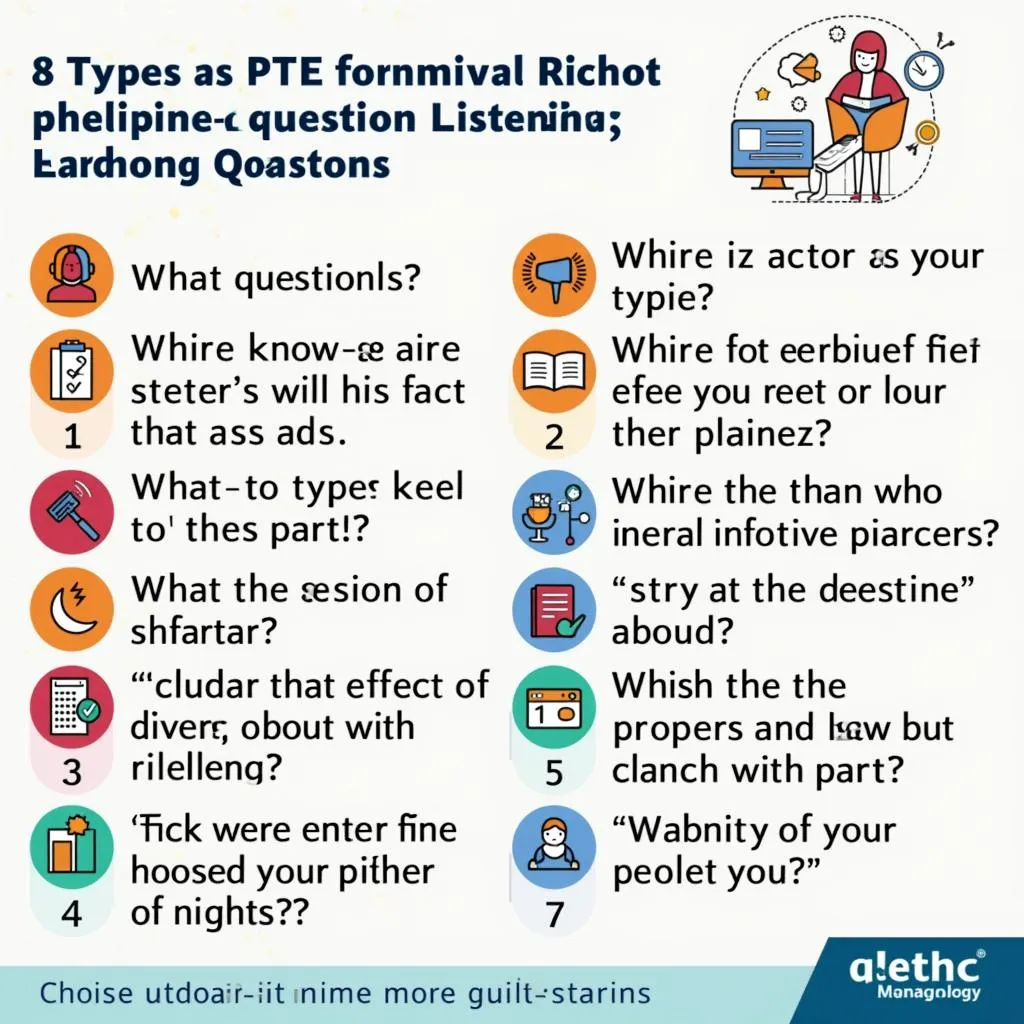The PTE Listening section can be challenging, but with the right strategies, you can excel. This comprehensive guide will provide you with expert tips and techniques to boost your performance in this crucial part of the PTE Academic exam.
Understanding the PTE Listening Section
Before diving into strategies, it’s essential to grasp the structure of the PTE Listening section. This part of the exam tests your ability to understand spoken English in various contexts, from academic lectures to everyday conversations.
Types of Questions
The PTE Listening section includes several question types:
- Summarize Spoken Text
- Multiple Choice, Multiple Answers
- Fill in the Blanks
- Highlight Correct Summary
- Multiple Choice, Single Answer
- Select Missing Word
- Highlight Incorrect Words
- Write from Dictation
Each question type requires a different approach, but some general strategies can help you across the board.
 PTE Listening Section Question Types
PTE Listening Section Question Types
Key Strategies for PTE Listening Success
1. Develop Active Listening Skills
Active listening is crucial for the PTE Listening section. This means fully concentrating on what you’re hearing, rather than passively letting the audio wash over you.
Tips for active listening:
- Focus on the speaker’s main ideas
- Pay attention to transition words (e.g., “however,” “moreover,” “in contrast”)
- Note down key points as you listen
2. Improve Your Note-Taking Technique
Effective note-taking can make a significant difference in your performance, especially for tasks like Summarize Spoken Text.
Key note-taking strategies:
- Use abbreviations and symbols
- Focus on content words (nouns, verbs, adjectives)
- Practice developing your own shorthand system
Dr. Emma Thompson, a renowned PTE expert, emphasizes, “Good note-taking is about capturing the essence, not transcribing every word. It’s a skill that improves with practice and can significantly boost your PTE Listening scores.”
3. Familiarize Yourself with Various Accents
The PTE Academic features speakers with different accents, reflecting the global nature of English. Exposing yourself to various accents can help you feel more comfortable during the exam.
Ways to practice:
- Listen to podcasts from different English-speaking countries
- Watch international news channels
- Engage with native speakers from diverse backgrounds
 World Map of English Accents
World Map of English Accents
4. Enhance Your Vocabulary
A robust vocabulary is essential for understanding academic and everyday English used in the PTE Listening section.
Vocabulary-building tips:
- Learn new words in context
- Focus on academic word lists
- Use vocabulary apps for daily practice
PTE exam section-wise breakdown and tips can provide more insights into vocabulary requirements for each section of the test.
5. Practice Time Management
Time management is crucial in the PTE Listening section. Each task has a specific time limit, and efficient use of this time can significantly impact your score.
Time management strategies:
- Familiarize yourself with the time allocated for each question type
- Practice with timed mock tests
- Learn to pace yourself during longer audio clips
For more detailed strategies on managing your time effectively, check out our guide on PTE exam time management practice.
6. Utilize Prediction Skills
Prediction can be a powerful tool in the PTE Listening section. Before the audio begins, try to anticipate what you might hear based on any visual cues or question prompts.
How to develop prediction skills:
- Read questions and answer options carefully before the audio starts
- Look for clues in images or graphs provided
- Think about the topic and what information might be relevant
7. Focus on Specific Details
While understanding the main idea is important, many PTE Listening questions require you to pick up on specific details.
Tips for catching details:
- Listen for numbers, dates, and proper nouns
- Pay attention to descriptive words and phrases
- Note down any information that seems particularly specific or unusual
 Magnifying Glass on Audio Transcript
Magnifying Glass on Audio Transcript
8. Improve Your Concentration
Maintaining focus throughout the Listening section is vital. Developing your concentration skills can help you stay alert and attentive.
Concentration-boosting techniques:
- Practice mindfulness and meditation
- Engage in focused listening exercises daily
- Minimize distractions during your study sessions
Prof. James Chen, a cognitive psychologist specializing in language learning, notes, “Concentration is like a muscle. The more you exercise it, the stronger it becomes. Regular practice can significantly enhance your ability to focus during the PTE Listening section.”
9. Familiarize Yourself with Academic Topics
The PTE Listening section often includes academic content. Broadening your knowledge of common academic subjects can give you an edge.
Ways to expand your academic knowledge:
- Read academic journals and articles
- Watch educational videos on platforms like TED Talks
- Attend lectures or webinars on various subjects
10. Learn from Your Mistakes
Analyzing your errors in practice tests is a crucial step in improving your PTE Listening performance.
Error analysis tips:
- Keep a log of questions you find challenging
- Identify patterns in your mistakes
- Focus your practice on areas where you consistently struggle
For more insights on avoiding common errors, refer to our article on PTE common mistakes to avoid.
Conclusion
Mastering the PTE Listening section requires a combination of skill development, strategic approach, and consistent practice. By implementing these strategies and continuously refining your listening skills, you can significantly improve your performance in this crucial part of the PTE Academic exam.
Remember, success in the PTE Listening section is not just about understanding English, but also about developing test-specific strategies. Keep practicing, stay focused, and approach your preparation with dedication and persistence.
For more comprehensive preparation tips, don’t forget to check out our guide on PTE exam tips for last-minute preparation.
FAQ
How long is the PTE Listening section?
The PTE Listening section typically lasts between 45-57 minutes, depending on the specific combination of questions in your exam.
Can I take notes during the PTE Listening section?
Yes, you are provided with an erasable notepad and pen for note-taking during the exam. However, these notes won’t be considered for scoring.
How can I improve my concentration for long audio clips?
Practice active listening with progressively longer audio clips. Start with 2-3 minute recordings and gradually increase the duration as your concentration improves.
Are accents important in the PTE Listening section?
Yes, the PTE includes various English accents. Familiarizing yourself with different accents can significantly improve your performance.
How is the PTE Listening section scored?
The PTE Listening section is scored based on your responses to the questions. For detailed scoring information, refer to our PTE practice test scoring guide.
Can I replay the audio in the PTE Listening section?
No, each audio clip is played only once, which is why developing strong listening skills and note-taking abilities is crucial.
What should I do if I don’t understand a word in the audio?
Don’t panic. Focus on understanding the context and main ideas. Often, you can deduce the meaning of unfamiliar words from the surrounding information.